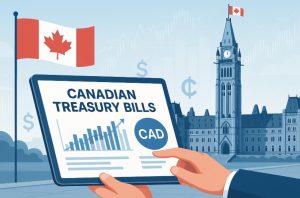Are you looking for a safe, flexible way to grow your savings without taking on high risk? Understanding how to buy treasury bills in Canada can open the door to government-backed investments that protect your principal and deliver modest, predictable returns.
Treasury bills, often called T-bills, are short-term debt securities issued by the Canadian government, making them one of the most secure options available for investors. Whether you’re a conservative investor aiming to preserve capital or someone looking to balance riskier investments in your portfolio, T-bills can play a valuable role.
This guide will walk you through where to buy them, how they work, current rates, tax considerations, and how they compare to other products like GICs. By the end, you’ll have a clear understanding of how T-bills fit into a smart, diversified investment strategy.
What Are Treasury Bills In Canada?

Treasury bills, also called T-bills, are short-term debt securities issued by the Government of Canada. When you buy a T-bill, you are essentially lending money to the government for a set period.
These bills are sold at a price lower than their face value, and when they mature, you receive the full face value. The profit you earn is the difference between what you paid and the face value at maturity.
For example, if you pay $980 for a T-bill with a face value of $1,000, you will receive $1,000 at maturity. Your return is $20, which represents the interest earned. This system makes T-bills predictable and secure because they are backed by the government and the returns are known in advance.
T-bills are generally issued with terms of one month, three months, six months, or one year, making them highly flexible. They are especially popular with conservative investors and institutions seeking safe, short-term investments.
Does Canada Offer Treasury Bills, And Are They Safe?
Yes, Canada offers treasury bills at both the federal and provincial levels. They are considered one of the safest investments available because they are backed by the government’s full credit.
Some key reasons why they are seen as safe include:
- They guarantee the return of your principal at maturity
- They have a short maturity period, reducing exposure to market risks
- They are less volatile compared to corporate bonds or equities
Because of these factors, many investors use T-bills as a way to balance higher-risk investments in their portfolios or to hold cash securely between investment decisions.
How Do Treasury Bills Compare To GICs In Canada?
Treasury bills and Guaranteed Investment Certificates (GICs) are both low-risk, fixed-term investments, but they work differently.
| Feature | Treasury Bills | Guaranteed Investment Certificates (GICs) |
| Issuer | Federal or provincial governments | Banks, credit unions, and other institutions |
| Maturity Period | 1 month to 1 year | Typically 1 to 5 years |
| Earnings Method | Difference between discounted purchase price and face value | Fixed interest rate over the term |
| Liquidity | More flexibility, shorter terms | Funds are locked in until maturity |
T-bills offer more flexibility to reinvest frequently, especially when interest rates are rising. GICs may provide slightly higher yields but require a longer commitment.
Where Can You Buy Treasury Bills In Canada?

If you are considering treasury bills as part of your investment strategy, knowing where to buy them is crucial. In Canada, there are several ways to access T-bills depending on your experience level, investment amount, and need for professional advice. Each option has its own process, benefits, and considerations.
1. Buying Through The Bank Of Canada
The Bank of Canada sells treasury bills through public auctions, typically geared toward institutional investors.
To participate, you must:
- Have a Canadian bank account
- Hold a valid Social Insurance Number (SIN)
- Submit competitive or non-competitive bids during auction windows
While possible for individuals, this approach can be complex, so it’s usually more common for large-scale investors.
2. Buying Through Financial Institutions
Many banks and credit unions offer T-bills to retail clients.
This is one of the simplest ways to invest because:
- Financial advisors guide you through the purchase process
- You can often include T-bills within larger investment portfolios
- Minimum investment amounts are usually set at $1,000
This route suits investors looking for convenience and support.
3. Buying Through Online Brokerages
Online and discount brokerages allow you to buy T-bills through the secondary market.
You will:
- Open an investment account
- Select the T-bills you want and set maturity preferences
- Benefit from potentially lower fees compared to full-service advisors
4. Working With Investment Advisors
An investment advisor can help tailor T-bill investments to your goals.
They handle:
- Selecting appropriate T-bills
- Managing reinvestment strategies
- Providing personalized financial advice
This option suits those who prefer a hands-off approach or want expert input.
What Are The Current Treasury Bill Rates In Canada?
Treasury bill rates in Canada change frequently, influenced by market demand, the Bank of Canada’s monetary policy, and economic conditions. These rates reflect the average sample yields from the secondary market, where T-bills are actively traded throughout the business day.
Here’s a snapshot of the recent treasury bill yields over the past several weeks:
| Series | 2025‑06‑18 | 2025‑06‑25 | 2025‑07‑02 | 2025‑07‑09 | 2025‑07‑16 |
| 1 month | 2.66% | 2.68% | 2.67% | 2.68% | 2.68% |
| 3 month | 2.66% | 2.67% | 2.65% | 2.64% | 2.66% |
| 6 month | 2.66% | 2.65% | 2.65% | 2.64% | 2.71% |
| 1 year | 2.66% | 2.64% | 2.62% | 2.64% | 2.73% |
From this data, you can see that:
- The 1-month rate has remained stable, with slight increases around late June.
- The 3-month rate dipped slightly in early July but has now rebounded to its late June level.
- The 6-month rate stayed steady but jumped noticeably from 2.64% to 2.71% by mid-July.
- The 1-year rate showed the biggest increase, climbing from 2.62% to 2.73% in the same period.
These small movements can matter when deciding when to buy or reinvest, especially if you are looking for the most competitive short-term returns. Tracking these weekly changes helps investors make informed decisions to maximize yields.
Can You Invest In Treasury Bill ETFs In Canada?

Instead of buying individual T-bills, you can invest in exchange-traded funds (ETFs) that hold a portfolio of government bonds, including T-bills. These ETFs are traded on stock exchanges, making them accessible to a wide range of investors.
One example is the Vanguard Canadian Government Bond Index ETF (VGV), which tracks the Bloomberg Global Aggregate Canadian Government Float Adjusted Bond Index.
This ETF focuses primarily on investment-grade government fixed-income securities and charges low fees, with a management fee of 0.15% and a management expense ratio of 0.17%. It also provides monthly distributions.
Investing in T-bill ETFs can be a convenient way to diversify across multiple government bonds without managing individual purchases.
How Much Do Treasury Bills Cost And What Is The Minimum Investment?
The minimum investment for most treasury bills is $1,000 when purchased directly. This amount can be higher if you are buying through auctions or brokers, depending on their requirements.
If you prefer to invest in treasury bill ETFs or money market funds, you can often start with much smaller amounts, sometimes as little as the price of one ETF unit or mutual fund share. This flexibility makes T-bills and related products accessible to a range of investors.
How Can You Calculate Treasury Bill Yields?
Calculating the yield on a treasury bill is essential for understanding how much you will earn.
The formula is:
(Face Value – Purchase Price) / Purchase Price × (365 / Days to Maturity) = Annualized Yield (%)
For example, if you buy a $1,000 T-bill for $986 with a maturity of 90 days, you would calculate:
(1000 – 986) / 986 × (365 / 90) = 5.8%
This formula gives you the annualized percentage yield, allowing you to compare it to other investment options even if the term is short.
How Are Treasury Bills Taxed In Canada?

The earnings you receive from treasury bills are classified as interest income. This means they are fully taxable at your marginal tax rate when held in a non-registered account.
Key points to remember:
- Only the interest (the difference between the purchase price and the face value) is taxable.
- Holding T-bills in a Tax-Free Savings Account (TFSA) shelters the income from taxes.
- Holding them in a Registered Retirement Savings Plan (RRSP) defers taxes until withdrawal.
Understanding these tax implications helps you plan where to hold your T-bills for maximum efficiency.
Is It Possible To Buy US Treasury Bills In Canada
Canadian investors can access US treasury bills through brokerages that offer international or cross-border services.
However, it’s important to consider several factors before purchasing:
- Currency exchange fees between Canadian and US dollars
- Different tax treatment and reporting obligations for foreign income
- Possible US withholding taxes depending on the type of account
It’s often recommended to work with an advisor or broker familiar with cross-border investments to navigate these complexities and ensure you meet all regulatory requirements.
Why Should Canadian Investors Consider Treasury Bills?
Treasury bills offer a range of benefits that appeal to Canadian investors:
- Government-backed security with minimal default risk
- Short-term commitments that provide flexibility
- Predictable earnings that can balance more volatile investments
By including T-bills in your portfolio, you can create a stable foundation that supports your broader investment strategy and financial goals.
Conclusion
Buying treasury bills in Canada is a straightforward yet powerful way to protect your savings while earning guaranteed returns. With options to purchase directly through the Bank of Canada, financial institutions, brokerages, or even through ETFs, there’s flexibility to match every investor’s experience level and goals.
While the returns on T-bills may be modest compared to stocks or corporate bonds, their government backing and short maturity terms provide valuable security, especially in uncertain markets.
Understanding the costs, yield calculations, and tax considerations will help you make informed decisions tailored to your financial plan. Whether you’re seeking a safe place to park funds temporarily or looking to add stability to a diverse portfolio, T-bills remain one of the most trusted and accessible investment options available to Canadians today.
FAQs
What is the minimum amount I can invest in Canadian treasury bills?
Most Canadian T-bills have a minimum purchase requirement of $1,000, though ETFs and mutual funds tracking T-bills may allow smaller investments.
How often do Canadian treasury bill rates change?
T-bill rates can fluctuate weekly based on economic factors like the Bank of Canada’s monetary policy and prevailing market conditions.
Can I lose money by investing in treasury bills?
Since T-bills are backed by the government, your principal is guaranteed as long as you hold them to maturity, making them one of the safest investments.
Are treasury bills better than GICs for short-term investing?
T-bills offer shorter maturities and flexibility to reinvest as rates change, while GICs often lock in funds for longer terms with fixed interest rates.
How are treasury bill ETFs different from buying individual T-bills?
ETFs bundle multiple government securities, offering easier access and diversification, but they come with management fees and trade like stocks.
Can I buy US treasury bills from Canada without a US account?
Yes, Canadian brokerages with cross-border access can help you purchase US T-bills, but you should understand the tax and currency implications.
Do I have to pay taxes on treasury bills held in a TFSA or RRSP?
No, T-bills held in tax-advantaged accounts like a TFSA or RRSP grow tax-free, but those in non-registered accounts generate taxable interest income.




